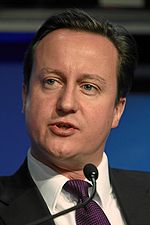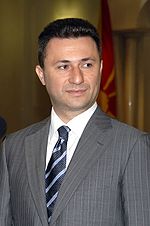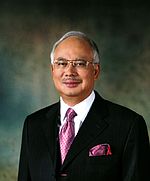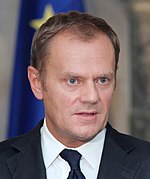Prime minister: Difference between revisions
Luckas-bot (talk | contribs) m r2.7.1) (robot Adding: jv:Perdhana Mentri |
No edit summary |
||
| Line 216: | Line 216: | ||
|[[Prime Minister of East Timor|East Timor]]||2002||-||dates||[[Xanana Gusmão]] |
|[[Prime Minister of East Timor|East Timor]]||2002||-||dates||[[Xanana Gusmão]] |
||
|- |
|- |
||
|[[Prime Minister of Egypt|Egypt]] ([[List of Prime Ministers of Egypt|List]])||1878||-||years||[[ |
|[[Prime Minister of Egypt|Egypt]] ([[List of Prime Ministers of Egypt|List]])||1878||-||years||[[Essam Sharaf]] |
||
|- |
|- |
||
|[[List of Prime Ministers of Equatorial Guinea|Equatorial Guinea]]||1963||-||dates||[[Ignacio Milam Tang]] |
|[[List of Prime Ministers of Equatorial Guinea|Equatorial Guinea]]||1963||-||dates||[[Ignacio Milam Tang]] |
||
Revision as of 01:45, 4 March 2011
| Part of the Politics series on |
| Executive government |
|---|
| Head of state |
| Government |
|
| Systems |
| Lists |
| Politics portal |
A prime minister is the most senior minister of cabinet in the executive branch of government in a parliamentary system. In many systems, the prime minister selects and can dismiss other members of the cabinet, and allocates posts to members within the Government. In most systems, the prime minister is the presiding member and chairman of the cabinet. In a minority of systems, notably in semi-presidential systems of government, a prime minister is the official who is appointed to manage the civil service and execute the directives of the head of state.
In parliamentary systems fashioned after the Westminster system, the prime minister is the presiding and actual head of the government and head of the executive branch. In such systems, the head of state or the head of state's official representative (i.e. the monarch, president, or governor-general) usually holds a largely ceremonial position, although often with reserve powers. The prime minister is often, but not always, a member of parliament and is expected with other ministers to ensure the passage of bills through the legislature. In some monarchies the monarch may also exercise executive powers (known as the royal prerogative) which are constitutionally vested in the crown and can be exercised without the approval of parliament.
As well as being head of government, a prime minister may have other roles or titles - the Prime Minister of the United Kingdom, for example, is also First Lord of the Treasury and Minister for the Civil Service.[1] Prime ministers may take other ministerial posts - for example during the Second World War Winston Churchill was also Minister of Defence (although there was then no Ministry of Defence). The Prime Minister of Australia, Gough Whitlam, was famous for forming his cabinet entirely of himself and his deputy as soon as the overall result of the 1972 federal election was beyond doubt (see First Whitlam Ministry).
History

The first actual usage of the term prime minister or Premier Ministre was used by Cardinal Richelieu when in 1625 he was named to head the royal council as prime minister of France. Louis XIV and his descendants generally attempted to avoid giving this title to their chief ministers. The term prime minister in the sense that we know it originated in the 18th century in the United Kingdom.[citation needed] Since medieval times monarchs of England and the United Kingdom had ministers in whom they placed special trust and who were regarded as the head of the government. Examples were Thomas Cromwell under Henry VIII; William Cecil, Lord Burghley under Elizabeth I; Clarendon under Charles II and Godolphin under Queen Anne. These ministers held a variety of formal posts, but were commonly known as "the minister", the "chief minister", the "first minister" and finally the "prime minister".
The power of these ministers depended entirely on the personal favour of the monarch. Although managing the parliament was among the necessary skills of holding high office, they did not depend on a parliamentary majority for their power. Although there was a cabinet, it was appointed entirely by the monarch, and the monarch usually presided over its meetings. When the monarch grew tired of a first minister, he or she could be dismissed, or worse: Cromwell was executed and Clarendon driven into exile when they lost favour. Kings sometimes divided power equally between two or more ministers to prevent one minister becoming too powerful. Late in Anne's reign, for example, the Tory ministers Harley and St John shared power.
In the mid 17th century, after the English Civil War and the Protectorate, Parliament had strengthened its position and it emerged even more powerful after the Glorious Revolution of 1688. The monarch could not establish any law or impose any tax without its permission. Thus it has been said that the House of Commons became a part of the government and it has been only a further step of this development that a new kind of prime minister should emerge. This turning point in the evolution of the prime ministership came with the death of Anne in 1714 and the accession of George I. George spoke no English, spent much of his time at his home in Hanover, and had neither knowledge of nor interest in the details of English government. In these circumstances it was inevitable that the king's first minister would become the de facto head of the government. From 1721 this was the Whig politician Robert Walpole, who held office for twenty-one years. Walpole chaired cabinet meetings, appointed all the other ministers, dispensed the royal patronage and packed the House of Commons with his supporters. Under Walpole, the doctrine of cabinet solidarity developed. Walpole required that no minister other than himself have private dealings with the king, and also that when the cabinet had agreed on a policy, all ministers must defend it in public or resign. As a later prime minister, Lord Melbourne, said: "It matters not what we say, gentlemen, so long as we all say the same thing."
Walpole always denied that he was "prime minister", and throughout the 18th century parliamentarians and legal scholars continued to deny that any such position was known to the Constitution. The title was first referred to on government documents during the administration of Benjamin Disraeli but did not appear in the formal British Order of precedence until 1905. George II and George III made strenuous efforts to reclaim the personal power of the monarch, but the increasing complexity and expense of government meant that a minister who could command the loyalty of the Commons was increasingly necessary. The long tenure of the wartime Prime Minister Pitt the Younger (1783–1801), combined with the mental illness of George III, consolidated the power of the post.
The prestige of British institutions in the 19th century and the growth of the British Empire saw the British model of cabinet government, headed by a prime minister, widely copied, both in other European countries and in British colonial territories as they developed self-government. In some places alternative titles such as "premier", "chief minister", "first minister of state", "president of the council" or "chancellor" were adopted, but the essentials of the office were the same. By the late 20th century the majority of the world's countries had a prime minister or equivalent minister, holding office under either a constitutional monarchy or a ceremonial president. The main exceptions to this system have been the United States and the presidential republics in Latin America, modelled on the U.S. system, in which the president directly exercises executive authority.
Bahrain's Prime Minister, Sheikh Khalifah bin Sulman Al Khalifah has been in the post since 1971, making him the longest serving non-elected Prime Minister.
Prime ministers in republics and in monarchiesThe post of prime minister may be encountered both in constitutional monarchies (such as Belgium, Denmark, Japan, the Netherlands, Norway, Malaysia, Spain,[2] Sweden, Canada, Australia, New Zealand, and the United Kingdom), and in republics in which the head of state is an elected official (such as Finland, France, Germany, Greece, Hungary, India, Italy, Ireland, Pakistan, Portugal, Montenegro, Croatia, Bulgaria, Romania, Serbia, Turkey). This contrasts with the presidential system, in which the president (or equivalent) is both the head of state and the head of the government. See also "First Minister", "Premier", "Chief Minister", "Chancellor", "Taoiseach" and "Secretary of State": alternative titles usually equivalent in meaning to, or translated as, "prime minister". The head of government of the People's Republic of China is referred to as the Premier. In some presidential or semi-presidential systems, such as those of France, Russia or South Korea, the prime minister is an official generally appointed by the president but usually approved by the legislature and responsible for carrying out the directives of the president and managing the civil service. (The premier of the Republic of China is also appointed by the president, but requires no approval by the legislature. Appointment of the prime minister of France requires no approval by the parliament either, but the parliament can force the resignation of the government.) In these systems, it is possible for the president and the prime minister to be from different political parties if the legislature is controlled by a party different from that of the president. When it arises, such a state of affairs is usually referred to as (political) cohabitation. Entry into officeIn parliamentary systems a prime minister can enter into office by several means.
Prime ministers and constitutionsThe position, power and status of prime ministers differ depending on the age of the constitution. Australia's constitution makes no mention of a Prime Minister of Australia. The People's Republic of China constitution set a premier just one place below the president of the PRC. While the president deals with international problems, the premier deals with national problems. For example, the earth quake in 2008, the premier will be the first to arrive, then the president arrived after to just examine the situation. Premier read as (Simplified Chinese: 总理; pinyin: Zŏnglĭ) in Chinese. Canada's constitution, being a 'mixed' or hybrid constitution (a constitution that is partly formally codified and partly uncodified) originally did not make any reference whatsoever to a prime minister, with her or his specific duties and method of appointment instead dictated by "convention". In the Constitution Act, 1982, passing reference to a "Prime Minister of Canada" is added, though only regarding the composition of conferences of federal and provincial first ministers. Germany's Basic Law (1949) lists the powers, functions and duties of the federal chancellor. Greece's constitution (1975) lists the powers, functions and duties of the Prime Minister of Greece. India's constitution (1950) lists the powers, functions and duties of the Prime Minister of India. Ireland's constitution, Bunreacht na hÉireann (1937), provides for the office of Taoiseach in detail, listing powers, functions and duties. Italy's constitution (1948) lists the powers, functions and duties of the Prime Minister of Italy. Japan's constitution (1946) lists the powers, functions and duties of the Prime Minister of Japan. Malta's constitution (1964) lists the powers, functions and duties of the Prime Minister of Malta. Malaysia's constitution (1957) lists the powers, functions and duties of the Prime Minister of Malaysia. Pakistan's constitution (1973) lists the powers, functions and duties of the Prime Minister of Pakistan. Spain's constitution (1978) regulates the appointment, dismissal, powers, functions and duties of the President of the Government. The United Kingdom's constitution, being uncodified and largely unwritten, makes no mention of a prime minister. Though it had de facto existed for centuries, its first mention in official state documents did not occur until the first decade of the twentieth century. Accordingly, it is often said "not to exist", indeed there are several instances of parliament declaring this to be the case. The prime minister sits in the cabinet solely by virtue of occupying another office, either First Lord of the Treasury (office in commission), or more rarely Chancellor of the Exchequer (the last of whom was Balfour in 1905). Exit from officeMost prime ministers in parliamentary systems are not appointed for a specific term in office and in effect may remain in power through a number of elections and parliaments. For example, Margaret Thatcher was only ever appointed prime minister on one occasion, in 1979. She remained continuously in power until 1990, though she used the assembly of each House of Commons after a general election to reshuffle her cabinet. Some states, however, do have a term of office of the prime minister linked to the period in office of the parliament. Hence the Irish Taoiseach is formally 'renominated' after every general election. (Some constitutional experts have questioned whether this process is actually in keeping with the provisions of the Irish constitution, which appear to suggest that a taoiseach should remain in office, without the requirement of a renomination, unless s/he has clearly lost the general election.) The position of prime minister is normally chosen from the political party that commands majority of seats in the lower house of parliament. In parliamentary systems, governments are generally required to have the confidence of the lower house of parliament (though a small minority of parliaments, by giving a right to block supply to upper houses, in effect make the cabinet responsible to both houses, though in reality upper houses, even when they have the power, rarely exercise it). Where they lose a vote of confidence, have a motion of no confidence passed against them, or where they lose supply, most constitutional systems require either: a) a letter of resignation or b) a request for parliamentary dissolution. The latter in effect allows the government to appeal the opposition of parliament to the electorate. However in many jurisdictions a head of state may refuse a parliamentary dissolution, requiring the resignation of the prime minister and his or her government. In most modern parliamentary systems, the prime minister is the person who decides when to request a parliamentary dissolution. Older constitutions often vest this power in the cabinet. (In the United Kingdom, for example, the tradition whereby it is the prime minister who requests a dissolution of parliament dates back to 1918. Prior to then, it was the entire government that made the request. Similarly, though the modern 1937 Irish constitution grants to the Taoiseach the right to make the request, the earlier 1922 Irish Free State Constitution vested the power in the Executive Council (the then name for the Irish cabinet). TitlesDifferent terms are used to describe prime ministers. In Germany and Austria the prime minister is actually titled Federal Chancellor ([Bundeskanzler] Error: {{Lang}}: text has italic markup (help)). In the Russian constitution the prime minister is actually titled Chairman of the government while the Irish prime minister is called the [Taoiseach] Error: {{Lang}}: text has italic markup (help) (which is rendered into English as prime minister), and in Israel he is 'Rosh HaMemshalah' meaning head of government. In many cases, though commonly used, "prime minister" is not the official title of the office-holder; the Spanish prime minister is the President of the Government ([Presidente del Gobierno] Error: {{Lang}}: text has italic markup (help)). Other common forms include president of the council of ministers (for example in Italy, [Presidente del Consiglio dei Ministri] Error: {{Lang}}: text has italic markup (help)), President of the Executive Council, or Minister-President. In the Scandinavian countries the prime minister is called statsminister in the native languages (i.e. minister of state). In federations, the head of government of subnational entities such as provinces is most commonly known as the premier, chief minister, governor or minister-president. In non-Commonwealth countries the prime minister may be entitled to the style of Excellency like a president. In some Commonwealth countries prime ministers and former prime ministers are styled Right Honourable due to their position, for example in the Prime Minister of Canada. In the United Kingdom the prime minister and former prime ministers may appear to also be styled Right Honourable, however this is not due to their position as head of government but as a privilege of being current members of Her Majesty's Most Honourable Privy Council.[3] In the UK where devolved government is in place, the leaders of the Scottish, Northern Irish and Welsh Governments are styled First Minister. In Pakistan, the prime minister is referred to as "Wazir-e-Azam", meaning "Grand Vizier". Description of the roleWilfried Martens, who served as Prime Minister of Belgium, described his role as follows:
Lists of prime ministersThe following table groups the list of past and present prime ministers and details information available in those lists. |
                                 |
Footnotes
- ^ Contrary to popular perception the two posts are separate and need not be held by the one person. The last prime minister not to be First Lord of the Treasury was Lord Salisbury at the turn of the 20th century. 10 Downing Street is actually the First Lord's residence, not the Prime Minister's. As Salisbury was not First Lord he had to live elsewhere as prime minister.
- ^ Although the roles of the Spanish head of government coincide with the definition of a 'prime minister', in Spain the position is in fact referred to as 'the Presidency of the Government'
- ^ "Privy Council Members". The Privy Council Office. Retrieved 19-Sep-2009.
{{cite web}}: Check date values in:|accessdate=(help)
See also
- Chancellor
- Chief minister
- Governor-General
- Head of state
- List of current heads of state and government
- List of democracy and election-related topics
- List of state leaders by year
- Monarch
- President
- Prime Minister of the United States
- List of heads of government of Russia
External links
- Website of the Prime Minister of Albania
- Website of the Prime Minister of Australia
- Website of the Prime Minister of Barbados
- Website of the Prime Minister of Belgium
- Website of the Prime Minister of Bosnia & Herzegovina
- Website of the Prime Minister of Canada
- Website of the Prime Minister of Croatia
- Website of the Prime Minister of France
- Website of the Prime Minister of Georgia
- Website of the Federal Chancellor of Germany
- Website of the Prime Minister of the Hellenic Republic (Greece)
- Website of the Prime Minister of Hungary
- Website of the Prime Minister of Iceland
- Website of the Prime Minister of India
- Website of the Taoiseach of Ireland
- Website of the Prime Minister of Israel
- Website of the Prime Minister of Italy
- Website of the Prime Minister of Japan
- Website of the Prime Minister of South Korea
- Website of the Prime Minister of Malaysia
- Website of the Prime Minister of Malta
- Website of the Prime Minister of The Netherlands
- Website of the Prime Minister of New Zealand
- Website of the Prime Minister of Norway
- Website of the Prime Minister of Poland
- Website of the Prime Minister of Romania
- Website of the Prime Minister of Russia
- Website of the Prime Minister of Singapore
- Website of the Prime Minister of Slovakia
- Website of the Prime Minister of Slovenia
- Website of the President of the Government of Spain
- Website of the Prime Minister of Sweden
- Website of the Prime Minister of Thailand
- Website of the Prime Minister of Trinidad and Tobago
- Website of the Prime Minister of Vietnam
- Website of the Prime Minister of the United Kingdom
